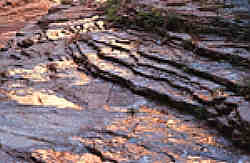Earth Sciences
Earth Sciences (also referred to as Geosciences), which deals with basic issues surrounding our planet, plays a vital role in the area of energy and raw materials supply.
Earth Sciences comprises subjects such as geology, geography, geological informatics, paleontology, mineralogy, petrography, crystallography, geophysics, geodesy, glaciology, cartography, photogrammetry, meteorology and seismology, early-warning systems, earthquake research and polar research.

Rising Temperatures Tied to Flowers’ Earlier Bloom
The results of a new study suggest that rising temperatures are leaving a mark on the world. According to a report published in the current issue of the journal Science, the first flowering of plants in Britain has changed by as much as 55 days over the past few decades in response to warmer weather. The results, the scientists say, are the “strongest biological signal yet of climatic change.”
Alastair Fitter of the University of York and his father, naturalist Richard Fitter, analyzed 47 y

Marsquake detection sensors will take search for water underground
Researchers at Imperial College London have just begun a 5-year project to design and build tiny earthquake measuring devices to go to Mars on the 2007 NetLander mission.
Unlike the instruments on next year`s European Mars Express/Beagle II mission, the Marsquake sensors will be the first to look deep inside the planet.
The internal structure of Mars is a key to understanding some fundamental questions about the planet including whether life ever existed there.
The sensors are c

Scientists Recreate Martian Environment
Scientists at the University of Leicester’s Space Research Centre are recreating the hostile environment found on Mars in their laboratory, with a device known as the Martian Environment Simulator (MES). The machine reproduces the temperature, air pressure and unbreathable atmosphere known to exist on Mars. The MES is currently being used to test equipment on the Beagle 2 lander, part of the European Space Agency’s Mars Express Spacecraft and due to arrive on Mars during Christmas 2003. The chance o

Bacterium May Reveal Location of Gold Deposits
Gold prospectors may one day rely on lowly bacteria to point them to deposits of the precious metal. Researchers have discovered that gold-laden soil often contains an abundance of spores belonging to a certain bacterium. The affinity humans have for gold aside, the ore in its soluble form is actually highly toxic to most living things. The common bacterium Bacillus cereus , however, possesses a unique resistance to the metal, allowing it to survive in a relatively vacant environmental niche:

Ocean Cores May Give Clues On Climate Change
Core samples taken from far below the ocean floor are helping a University of Edinburgh geologist to form a picture of dramatic climate changes which took place 30 to 40 million years ago. Dr Bridget Wade is part of an international team of scientists studying climate shifts between the Eocene period – the warmest cycle in the last 65 million years – and the cooler Oligocene period, which saw the first major build-up of Antarctic ice. The study could shed new light on present climate trends as the Eo

Dinsaurrific!
The most comprehensive picture yet of how dinosaurs evolved has been produced by a team at Bristol University.
More than 1,000 species of dinosaurs have been named since the first skeletons were dug up in the 19th century, and unravelling their patterns of evolution has been a major area of research.
Since 1980, over 150 evolutionary trees of dinosaurs have been published, most of them looking at small groups of species. The Bristol researchers have put all of these smaller